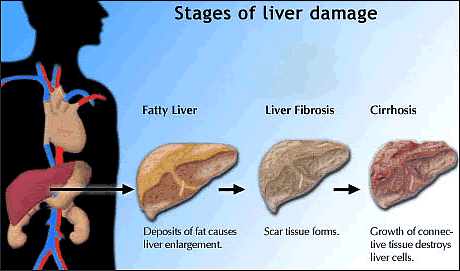Liver Disease
Progression in HIV/HCV Coinfected People
| SUMMARY:
Liver stiffness measured by FibroScan is a good predictor
of liver cancer, end-stage liver disease or death among
people with HIV/HCV coinfection, researchers reported as
EASL 2011. |
By
Liz Highleyman
A number of studies have shown that HIV
positive people with hepatitis
C virus (HCV) coinfection tend to experience more rapid
liver disease progression than people with hepatitis
C alone -- though just how much more rapid remains subject
to controversy.
One factor that may help explain conflicting study findings
is that outcomes may differ depending on whether investigators
evaluate liver damage according to liver biopsies or transient
elastography (FibroScan), which uses sound waves to measure
liver "stiffness."
As reported in a poster presented at the European Association
for the Study of the Liver's International Liver Congress (EASL
2011) this month in Berlin, T.M. Vu and colleagues from
Johns Hopkins looked at the relationship between clinical outcomes
and liver stiffness measurement in HIV/HCV
coinfected adults.
Liver stiffness has been shown to correlate with histological
stages (for example Metavir fibrosis stages F0 through F4),
the researchers noted as background, but the degree to which
liver stiffness predicts clinical outcomes is not clear. Transient
elastography is generally better at distinguishing absent or
mild fibrosis from advanced fibrosis
or cirrhosis
than it is at distinguishing between intermediate stages.

Nearly
300 HIV/HCV coinfected patients at the Johns Hopkins HIV clinic
underwent liver stiffness measurement between 2005 and 2009.
About two-thirds of participants were men, 88% were black, the
median age was 50 years, and about 75% had a history of injection
drug use. Overall they had well-controlled HIV disease, with
a median CD4 cell count of 420 cells/mm3 and 75% with HIV viral
load < 400 copies/mL.
Transient elastography was performed by experienced technicians.
No fibrosis was defined as a liver stiffness measurement of
< 8.0 kiloPascals (kPa), fibrosis was defined as 8.0-12.3
kPa, and cirrhosis was defined as > 12.3 kPa.
The researchers prospectively followed participants for a median
of just under 2 years to evaluate clinical outcomes including
hepatocellular
carcinoma (HCC), end stage liver disease (ESLD), and death
due to any cause. Outcomes were abstracted from medical records
and the National Death Index.
Results
 |
The
median liver stiffness at baseline was 8.3 kPa. |
 |
Based
on transient elastography results, 49% of participants had
no fibrosis, 27% had fibrosis, and 24% had cirrhosis. |
 |
Incidence
rates of HCC, ESLD, or all-cause mortality varied according
to liver stiffness classification: |
| |
 |
<
8.0 kPa: 14.9 per 1000 person-years; |
 |
8.0-12.3
kPa: 32.6 per 1000 person-years; |
 |
>12.3
kPa: 75.8 per 1000 person-years. |
|
 |
In
a multivariate analysis, factors independently associated
with greater risk of HCC, ESLD, or death were: |
 |
 |
Liver
stiffness > 12.3 kPa (incidence rate ratio 3.9,
or about a 4-fold higher risk); |
 |
Age
> 50 years (incidence rate ratio 4.5). |
|
 |
Conversely,
having a CD4 cell count > 350/mm3 was protective against
these clinical outcomes (incidence rate ratio 0.1). |
Based
on these findings, the researchers concluded, "In HIV/HCV
coinfected adults, liver stiffness was independently associated
with increased risk of important clinical outcomes, including
liver failure and death."
"These data validate liver stiffness measurement as a prognostic
marker," they added, "and suggest the potential role
of liver stiffness measurement for clinical decision-making
related to treatment and HCC screening."
Investigator
affiliation: Johns Hopkins University School of Medicine and
Johns Hopkins University School of Public Health, Baltimore,
MD.
4/12/11
References
TM
Vu, C Sutcliff, S Mehta, et al. Baseline liver stiffness measured
by transient elastography is independently associated with risk
of end-stage liver disease and death among HIV/HCV co-infected
adults. 46th Annual Meeting of the European Association for
the Study of the Liver (EASL 2011). Berlin. March 30-April 3.
Abstract
1069.
